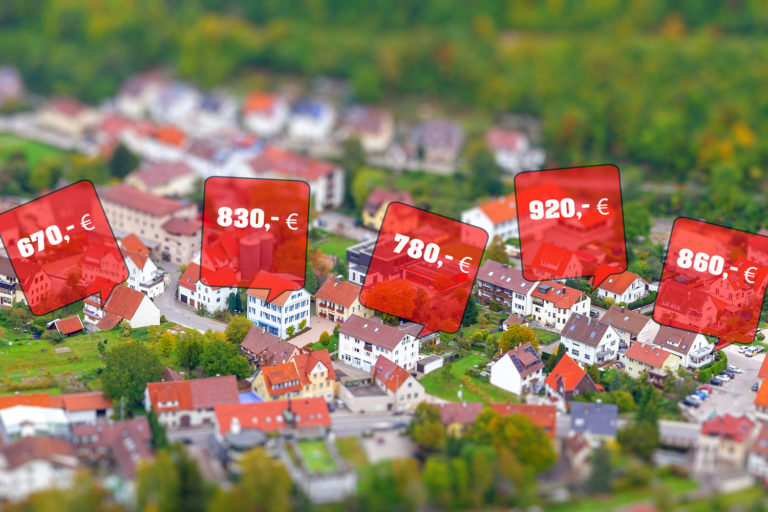Residential Investments in Germany – June 2022
27. May 2022

27. May 2022

Dear Reader,
The issue of the municipalities’ powers of pre-emptive purchase is once again making waves throughout the industry. At the end of 2021, the Federal Administrative Court in Leipzig ruled that authorities may only exercise their right if there is actually a deficit or defect within the meaning of the German Building Code – and not merely the presumption that the future owner might want to increase the rent, for example, after an energy efficiency upgrade.
However, it was always unlikely that the ruling would restore peace in this matter. In February, parliamentarians from the left-wing Die Linke party introduced their own, admittedly futile, bill to more clearly define municipalities’ pre-emptive purchase rights. The draft that followed three months later from the Federal Ministry of Construction went even further than the proposal from Die Linke: The public good should provide sufficient grounds for a pre-emptive purchase. This issue will therefore continue to preoccupy housing investors for a long time after the Leipzig ruling – presumably in an even more extreme form than before. By contrast, the programme to upgrade buildings to make them more energy-efficient is expected to be dealt a real blow as a result of the many so-called avoidance agreements that are expected to be concluded in order to avoid pre-emptive purchases.
We hope you enjoy reading this latest edition of our newsletter.
Your Jürgen Michael Schick & Holger Friedrichs

Sascha Hertach | Member of the Board, Arbireo Capital AG
Strong demand from professional investors for German residential real estate has been increasingly served by large portfolio transactions in recent years. 2021, which chalked up a record transaction volume of €49.8 billion (source: JLL), stands out in particular, as almost half of the total, €23.5 billion, was attributable to Vonovia’s acquisition of the Deutsche Wohnen portfolio. After all, portfolio transactions are the only way to manage the tens of thousands of residential investments per year. The question is whether this is the best acquisition strategy for investors. I have my doubts.
The advantage of portfolio transactions in the housing market is obvious: apartments are granular assets. Combining several smaller units into a larger overall package reduces the time and effort required to process individual transactions. At the same time, the diversification effect reduces the larger portfolio’s exposure to risk: One or two “bad apples” in the cart are no big issue and are accepted as a minor inconvenience.
The risk of stranded assets puts a kink in the portfolio calculation
But will this calculation still play out in the long run? Yield compression in recent years has ensured that there is hardly any cushion to offset any losses from individual properties. Every transaction is calculated with a very sharp pencil; price-to-rent ratios of thirty or forty times annual rental income are no longer unusual, even in portfolio transactions. The write-off of even a single property can destabilise the planning of any large investment.
And this may be precisely what is happening more and more frequently. Because in view of the debate about sustainability and environmental protection, it is no longer just a question of temporary rent reductions or minor repairs, but of “stranded assets,” or properties that no longer meet the standards of tenants and investors and are therefore no longer marketable. Such total losses are almost impossible to compensate for in the long run.
Investors who closely analyse every single investment from the outset and steer clear of large portfolios with combined risks that are difficult to identify are certainly at an advantage. This is especially true for smaller transaction managers. The prerequisites, however, are market access, networking within the industry, and in-house residential real estate market expertise. The greater effort is worthwhile when applied over a correspondingly long holding period, as it is only incurred once, while risks increase over time.
Large-scale investors and asset managers will continue to rely heavily on portfolio acquisitions. This will be a matter of necessity, because those who take too long to analyse, consider and negotiate will quickly be outflanked by the competition in a bidding war. Fortunately, those who can afford to make a narrow and precise selection on an individual transaction basis, can build up a portfolio entirely free of any “bad apples”.

André Vollbach | Managing Director, HIH Property Management GmbH
More than 13 years after the first “green building” certificate was issued in Germany, the industry seems further from a uniform sustainability standard than ever before. Investors and property developers can decide for themselves whether they prefer a European certificate or an American one – or to get both certifications to be on the safe side. Each of these certificates, in turn, has different quality levels such as Silver, Gold and Platinum – whereby the Platinum standards of 2015 are not even equivalent to Gold awards under the same systems today.
Status quo: Property managers have the “burden” of making decisions
Although these certificates and systems are based on a wide range of sustainability criteria, they do not form a framework or guideline that property managers in German-speaking countries can follow. The framework that does apply is the Disclosure and EU Taxonomy Regulation, which has been in force since the first of January this year. Now, one could claim that these regulations are only directed at funds or, at a stretch, asset managers. But the real impact is achieved in the daily work on the ground and in the properties, which is why property managers also need to take note. Ultimately, it is up to property managers to decide to what extent to implement ESG measures in order to achieve defined sustainability goals, both in everyday life and as elements of an overarching corporate strategy. Property managers are therefore free to choose whether they want to fulfil only the necessary minimum or whether they want to stay one step ahead of tomorrow’s regulations. However, it remains to be determined to what extent a property manager who acts less sustainably can meet the requirements of increasingly ESG-oriented investors.
Legislation in itself does not create uniformity
Given this confusing constellation and the largely voluntary nature of more complex sustainability measures, it is not surprising that initiatives such as GRESB and ECORE have set themselves the goal of ensuring the comparability of even the most diverse real estate portfolios in terms of sustainability and thus, ultimately, of allowing the work of property management to be evaluated more transparently. In addition to the various certifications, other regulations such as the aforementioned EU Taxonomy Regulation also play their part. However, apart from the fact that these are two distinct systems with partial overlaps, many investors have chosen to analyse just one set of criteria.
But although each new catalogue of criteria and each revision of existing regulations provides further differentiation, surprisingly such refinements also create stimuli for a long-awaited policy framework. The different certification systems and initiatives demand, at least in part, a uniform data basis, including reliable figures on current consumption and waste generated. Ultimately, these criteria and databases can be applied parallel to the Global Reporting Initiative (GRI), the German Sustainability Code and the Corporate Sustainability Reporting Directive (CSRD), for example, in order to develop a suitable strategy and implement it efficiently. But of course, someone has to do the upstream work and define and clarify the available adjusting mechanisms and influences.
Data management enables both: individualisation and standardisation
These data, often uncollated and at best stored in Excel tables at property level, have been collected and maintained by property managers for years now. These databases are becoming more and more extensive, in part as a result of the installation of smart metering systems, but also due to the fact that many properties can now be compared over a period of years. The practice of concluding framework agreements with operating companies to bundle services also helps to increase the standardisation in daily management workflows. At the same time, such an approach allows for greater flexibility in investor reporting. If the data can be retrieved at the push of a button, they are easier to adapt to the diverse requirements of individual investors and systems.
In other words, the expansion of digitalisation and transparency in property management ensures that processes are not only documented but constantly optimised. This means that best case scenarios at property level can be beneficially applied across the entire portfolio. In this way, we are approaching standards in property management and shaping the framework for action across the entire industry.

Moritz Kraneis | Managing Director, Deutsche Zinshaus Gesellschaft mbH
A potential transaction volume of €100 billion in Germany – this confident, but by no means far-fetched, forecast made brokerage houses sit up and take notice in early October 2021. The remarkable results posted on the German investment markets are largely attributable to the residential segment. According to CBRE, residential real estate has established itself as the strongest asset class, chalking up almost €21 billion of transactions in the third quarter of 2021. And this impressive total is by no means solely a result of the large-scale portfolio sales that have dominated recent media coverage. No, it is an outcome that owes much to the fact that investors with a high proportion of commercial space in their portfolios have been prioritising diversification.
However, while in the office segment it is primarily Grade-A properties in prime locations that have proven their stability, this is by no means the case in the residential sector. In particular, the inner cities of Germany’s largest cities are exhibiting signs of overheating and yields in the core segment have fallen to an all-time low of 2.24 per cent. In peripheral districts, in contrast, both absolute purchase prices and rental prices – measured against household income – are still relatively low. In addition, for some years now there has been a migratory trend from the urban core to the suburbs and exurbs, and rural communities on the edges of major cities have benefited the most.
However, this creates a fundamental problem. International investors are still drawn to real estate assets in Germany because of the high level of security they offer. An investor from the Asia-Pacific region or the United States who is looking for a “safe haven” in the German residential market is more likely to find an attractive investment opportunity in an exurban location such as Hanau and Hattersheim than in Frankfurt’s Westend. Why? Because such locations exhibit constantly positive market dynamics (without overheating tendencies) and, consequently, a much better overall performance. However, many investors are not even aware of these market opportunities – or that these cities even exist. As a result, most institutional investors, who according to Savills now account for 49 per cent of the investment market, continue to allocate much of their capital to the supposedly safe Top 7 cities.
Then there is a possible perception bias: In terms of ESG in the residential segment, the focus is all too often on forward deals for new properties built to the highest energy efficiency standards. However, modernising and upgrading the millions of properties in Germany’s existing building stock is an equally important lever as we strive for a major positive impact on the environment and climate. Thus, if investors align their investment strategies appropriately, they can also achieve their ESG targets via investments in the existing property segment.
My conclusion: The real estate industry needs to do more to establish better networks and explain the benefits of its products, especially in the residential sector. In particular, markets in regional centres have so far been largely ignored by institutional investors – and conversely, many local players do not have adequate connections to international investment and asset managers. As a result, fund solutions will come to dominate for years to come, bundling properties into portfolios. However, it also remains to be seen whether direct ownership will increase in the long term, and whether, a few years from now, property viewings will kick off with the words: “Ladies and Gentlemen, welcome to Hattersheim.” For investors who have specialised in these markets for years, the positives would be tangible.

Jürgen Michael Schick, FRICS | President, IVD, Immobilien Verband Deutschland e.V.
If you take a stroll through Berlin’s 72 urban conservation areas, you will rarely come across any blots on the cityscape. Of course, architectural tastes differ, but you’d be hard pressed to find buildings in really deplorable conditions in the sense of neglect or disrepair. And yet Berlin’s districts have exercised their pre-emptive rights to purchase apartment buildings in urban conservation areas on 77 occasions since 2017. In an additional 292 cases, municipal authorities have concluded agreements with buyers, which means they never had to exercise their pre-emptive rights at all. Wrongly, as the Federal Administrative Court ruled in late 2021 in response to a specific case from Berlin. The highest administrative court in Germany ruled that municipalities may not exercise their pre-emptive purchase rights on the basis of the mere presumption that the future owner might use the property in a way that undermines the objectives of the conservation area, i.e. because the future owner might want to exploit the potential for rent increases or might come up with the “absurd” idea of upgrading the property to make it more energy-efficient. The Federal Administrative Court was crystal clear: mere presumption of future misuse does not constitute a deficit or defect within the meaning of the Federal Building Code (BauGB). To come to this conclusion, one actually only has to be able to read. Because the law clearly defines the limits of municipal pre-emptive purchase rights.
In the world of law, the wording of a legal provision offers just one route to reaching your goal. Berlin’s district and administrative courts, however, preferred to rule in accordance with what they assumed was the purpose of the pre-emptive purchase provisions, namely to protect tenants from displacement. Berlin’s planning authorities clearly considered the clarity of the law to be an editorial oversight and were convinced that they had a right to exercise their pre-emptive purchase powers in this way.
Within seconds of the Federal Administrative Court’s ruling, demands for new legislation started to intensify. After all, negotiations between Germany’s new coalition partners at the federal level had already agreed to launch a review into the very same issues. Hot on their heels, the left-wing parliamentarians of Die Linke announced they would present their own bill, which they did in mid-February 2022. Die Linke’s proposal would restore the previous practice by allowing municipal authorities to exercise their pre-emptive purchase rights or enforce stringent restrictions on the basis of the mere presumption that the future owner might use the property in a way that has a negative impact on the conservation area. Although Die Linke’s proposed bill, as an opposition motion, has no chance of success, it has at least served to light a fire under the traffic light coalition. A few days ago, the Federal Ministry of Transport, Building and Urban Affairs launched internal consultations on its own bill, which is even more radical than Die Linke’s proposal. In short, it stipulates that pre-emptive purchase rights may be exercised solely on the basis of the public good. Die Linke’s politicians probably never imagined that the traffic light coalition’s proposals would be more left wing than their own.
At this moment, it is not possible to say what will happen next with any real sense of certainty. However, as a result of a public hearing of the Bundestag’s Building Committee on May 9, 2022 to seek expert opinions on Die Linke’s proposal, it seems likely that new legislation is on its way. The SPD and the Greens in particular want municipalities to have pre-emptive purchase rights, even where there is no anecdotal evidence of a realistic threat of displacement. Taking a sober view, it would seem that the impact of an additional pre-emptive purchase right would be quite manageable. After all, Germany’s tenancy laws already offer tenants significant protection from displacement. Nevertheless, problems could arise in relation to climate protection, especially where owners have already concluded so-called avoidance agreements (Abwendungsvereinbarungen) with local authorities. These agreements usually require the new owner to preserve the building’s current condition for decades to come. Thus, the owner has little scope for energy-saving or other modernisation measures. In some cases, the agreements even contain rent ceilings, which has nothing whatsoever to do with urban development. The entire discussion about pre-emptive purchase rights is a nuisance. Nonetheless, it does create an opportunity to resolve the conflict between climate protection and social compatibility goals. The job now, however, is to complete the consultation process agreed upon in the coalition agreement and demonstrate the benefits of such a pre-emptive purchase right for the general public.
This article was first published in Das Grundeigentum.

In the wake of a landmark decision by the Federal Administrative Court on November 9, 2021 to outlaw municipal authorities’ exercise of pre-emptive rights to purchase properties located in conservation areas, politicians have decided that new legislation is the answer. As a reaction to the initiative of the federal states of Berlin, Bremen and Hamburg, the Bundesrat is making a strong case to tighten the wording in the relevant sections of the German Building Code. The restoration of municipal pre-emptive purchase rights was also discussed in a public hearing of the Committee for Housing, Urban Development, Construction and Municipalities at the beginning of May. The plans of Federal Minister for Housing, Urban Development and Building, Klara Geywitz (SPD), have met with criticism throughout the real estate sector. According to the real estate association IVD, a municipal pre-emptive purchase does not create any added value: a public landlord is per se no better than a private landlord. And, as the IVD points out, tenancy law already protects existing tenants anyway. The IVD is clear: Rather than discussing a new version of pre-emptive rights, politicians should focus more on new construction.
In April, the District Court of Spandau issued a ruling on the 2021 Berlin rent index in which demands for rent increases were rejected. The judges ruled that the 2021 Berlin rent index did not fulfil the criteria of a “qualified rent index”. The case related to the second consecutive update to the index, which was deemed invalid. The District Court of Wedding, on the other hand, issued a ruling in support of the 2021 index. Two such contradictory judgements in such a short space of time have created legal uncertainty – and dented confidence in the rent index. Without a valid index, the rental price brake (Mietpreisbremse) cannot be applied. The IVD criticised the legal foundations of the latest update to the rent index as early as 2021. Even with the District Court of Wedding approving the 2021 rent index, the question remains as to how the state of Berlin can produce a lawful and reliable rent index in years to come.

Federal Finance Minister Christian Lindner (FDP) has given the starting signal for real estate transfer tax reform. From the initial consultations, it is clear that politicians are striving to lower the hurdles for acquiring real estate. Plans include giving the federal states the power to reduce the real estate transfer tax rate to zero. It is hoped that this would relieve the burden on private first-time buyers. Michael Schick, President of the German Real Estate Association IVD, welcomed the plans: Especially for young people, any dreams of owning their own home often come to nothing because their savings are not enough for a deposit and to get a mortgage. For this reason, the IVD believes that the proposed reforms are an important step in the right direction and could give middle-income households access to home ownership. In order to further promote sustainability, the IVD also advocates a real estate transfer tax refund for energy-efficient renovations.